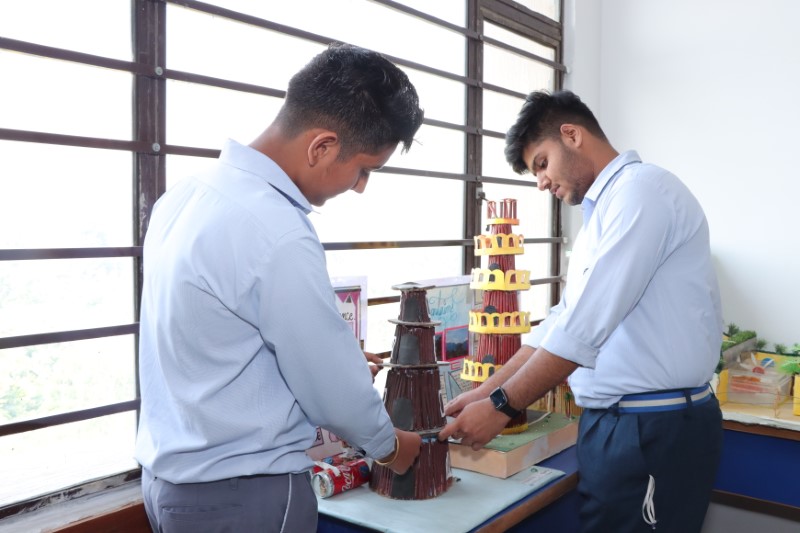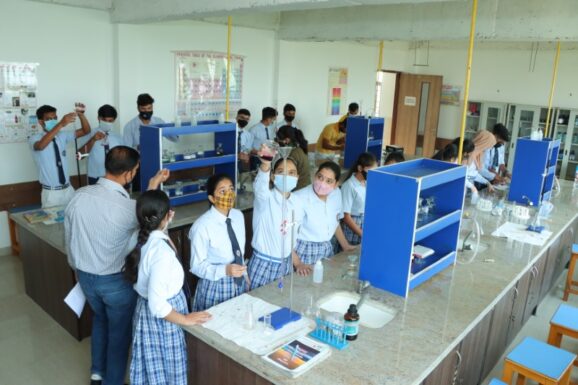At Greater Noida World School (GNWS), we believe the early years of a child’s life are the perfect time to spark a love for learning. For our nursery and kindergarten students, we use a Montessori-based approach—a way of teaching that puts the child at the center. It’s simple, gentle, and designed to help little ones grow naturally. Here’s how we make this special method work for your child.

What Montessori Means for Us
Montessori is all about letting kids learn at their own pace. Instead of forcing them to sit still and listen, we give them freedom to explore. At GNWS, we mix this idea with care and structure. Our nursery and kindergarten classrooms are calm, happy places where children feel safe to try new things. We don’t push them too hard—we guide them, letting their curiosity lead the way.
Hands-On Learning
Young kids learn best when they touch, move, and play. In our Montessori-based classrooms, we use special tools called “materials.” These might be wooden blocks for counting, colorful beads for sorting, or puzzles for shapes. For example, a child might pour water between cups to understand size or stack cubes to learn about balance. These activities aren’t just fun—they teach Math, language, and problem-solving in a way that feels like a game.
Every corner of the room has something to do. One child might trace letters in sand to practice writing, while another builds a tower to learn about height. They choose what interests them, and our teachers watch closely, stepping in to help when needed.
Freedom with Gentle Rules
In a Montessori setup, kids have choices, but it’s not chaos. At GNWS, we set simple rules—like cleaning up after playing or taking turns—so they learn responsibility too. A child might decide to paint, then put the brushes back when they’re done. This freedom helps them feel big and trusted, while the rules teach them how to care for their space and friends.
We don’t rush them. If a nursery student wants to spend extra time matching colors, that’s fine. If a kindergarten child loves a storybook, they can read it again. This builds confidence because they’re in charge of their learning, not pushed to keep up.
Growing Independence
One big goal of our Montessori approach is teaching kids to do things themselves. In our classrooms, everything is child-sized—low shelves, small chairs, tiny sinks. A nursery student might button a shirt on a practice board, while a kindergarten child learns to tie shoelaces. These “practical life” tasks—like pouring juice or sweeping crumbs—make them proud and ready for daily life.
Teachers don’t do everything for them. If a child spills water, we show them how to wipe it up. If they can’t reach a toy, we encourage them to ask a friend. This builds a “I can do it” spirit that stays with them as they grow.
Mixing Play and Learning
Play is how young kids understand the world, and we make it a big part of Montessori at GNWS. A sandbox becomes a place to learn about wet and dry, while a pretend kitchen teaches sharing and counting. Songs and dances help with rhythm and words. Even outdoor time—running, climbing, or digging in the garden—teaches them about nature and their bodies.
For example, a kindergarten group might plant seeds, water them, and watch them sprout. They’re playing, but they’re also learning Science and patience. It’s a natural way to grow their minds without them even knowing it.
Caring Teachers as Guides
Our teachers are more like helpers than bosses. They watch each child, noticing what they like or need. If a nursery student struggles with a puzzle, the teacher sits beside them, offering quiet tips. If a kindergarten child is ready for bigger challenges, they suggest new activities, like writing their name. This personal care makes sure every little learner feels seen and supported.
They also keep the room peaceful. With soft voices and kind words, they show kids how to be gentle with each other. It’s a warm space where young ones thrive.
Building Social Skills
Even at this young age, kids learn to get along. In our Montessori classrooms, they work side by side—sometimes alone, sometimes together. A nursery child might share crayons with a friend, while kindergarten students team up to build a block city. They learn to wait, help, and say “thank you.” These small moments shape them into kind, thoughtful people.
We also mix ages a little. Older kindergarten kids might show nursery ones how to roll a mat or stack cups. This builds friendship and lets them learn from each other, like a big family.
A Space Made for Them
Our classrooms are bright and simple, with natural light and soft colors. Everything is easy to reach, from books to toys. Outside, we have a playground with slides, sandpits, and space to run. There’s even a splash pool for hot days. This setup lets kids move, play, and learn without feeling stuck. It’s their world, built just for them.
Why Parents Love It
Parents see the difference our Montessori-based approach makes. Their nursery and kindergarten kids come home happy, talking about what they did. They’re more independent—tying shoes, eating alone, or picking up toys. They’re curious too, asking questions about bugs or stars. This method doesn’t just teach—it helps them grow into confident, caring little people.
Our Promise at GNWS
At Greater Noida World School, our Montessori-based learning for nursery and kindergarten is about starting right. We give young children freedom, tools, and love to explore their world. It’s not about rushing them to read or count—it’s about letting them bloom naturally. This foundation sets them up for a lifetime of learning, and we’re proud to be part of that journey.

